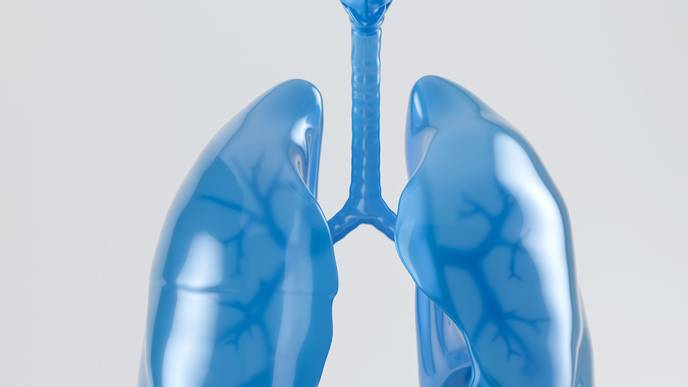Single-Cell Atlas of the Whole Human Lung

06/13/2023
First integrated Human Lung Cell Atlas reveals insights into lung diseases
The largest and most comprehensive cell map of the human lung is announced in Nature Medicine today (8 June). Revealing the great diversity of cell types in the lung and key differences between health and disease, the Human Lung Cell Atlas will be a valuable resource for lung researchers.
By combining data from nearly 40 studies, researchers from the Wellcome Sanger Institute, Helmholtz Munich, University Medical Center Groningen, and their collaborators created the first integrated single-cell atlas of the lung, revealing rare cell types and highlighting cellular differences between healthy people. In addition, the study found common cell states between lung fibrosis, cancer and COVID-19, offering new ways of understanding lung disease, which could help identify new therapeutic targets.
The study is part of the global Human Cell Atlas* (HCA) initiative to map every cell type in the human body, to transform our understanding of health, infection and disease.
Lung research has benefited greatly from recent single-cell studies that show which genes are active in each cell. Despite this, the research has been limited so far by the number of samples and individuals included per study.
Now, a large team of researchers has successfully combined 49 lung datasets, from nearly 40 separate studies, into a single integrated Atlas, using advanced machine learning. By pooling and integrating datasets from every major single-cell RNA-sequencing lung study published to date, the team created the first integrated Human Lung Cell Atlas. This Atlas spans over 2.4 million cells from 486 individuals and gives new insights into lung biology that were not possible before.
“A comprehensive organ atlas requires many datasets to capture the diversity between both cells and individuals, but combining different datasets is a huge challenge. We developed a benchmarking pipeline to find the optimal method to integrate all datasets into the Atlas, using artificial intelligence, and combined knowledge and data from almost 40 previous lung studies. Including data from more than a hundred healthy people, the atlas shows differences in the lung cells from individuals of different ages, sex and smoking history.”
Dr Malte Luecken, a senior author on the paper and Group leader at the Institute of Computational Biology and the Institute of Lung Health and Immunity at Helmholtz Munich
“Obtaining a refined lung atlas helps us understand the cellular landscape of our respiratory system and will enable us to better understand how diseases, such as COVID-19 or asthma, occur and how we might prevent them. What makes our study so important is the vast amount of data analysed, with information from over 400 individuals, and over 40 datasets, many of which have been developed at the Wellcome Sanger Institute.”
Dr Kerstin Meyer, Principal Staff Scientist in the Cellular Genetics team at the Wellcome Sanger Institute
While the core of the Human Lung Cell Atlas is data from healthy lungs, the team also took datasets from more than 10 different lung diseases and projected these onto the healthy data, to understand disease states.
The team discovered that different lung diseases shared common immune cell states, including the finding that a subset of macrophages (a type of immune cell) shared similar gene activity in lung fibrosis, cancer and COVID-19. The shared states indicate that these cells could play a similar role in scar formation in the lung in all three diseases, and provide pointers for potential therapeutic targets.
“This is the first effort to compare healthy and diseased lungs in one study in an integrated way. Our study not only supports the presence of lung fibrosis in COVID-19, it allows us to identify and define a shared cell state between lung fibrosis, COVID-19 and lung cancer patients. Finding these shared disease-associated cells is really exciting, and reveals a totally different way of looking at lung diseases, opening possibilities for novel treatment targets and developing treatment response biomarkers. Our findings also suggest that therapies working for one disease may help alleviate others.”
Professor Martijn Nawijn, a senior author on the paper and Professor at the University Medical Center Groningen, the Netherlands
The Lung Atlas Integration project was an international collaborative effort with nearly 100 partners from more than 60 departments, including key researchers from Helmholtz Munich, University Medical Center Groningen, Northwestern University Feinberg School of Medicine and the Sanger Institute. The team is part of the Human Cell Atlas Lung Biological Network**, which has its roots in the Chan Zuckerberg Initiative Seed Networks for the Human Cell Atlas, and the European Union funded lung network, DiscovAIR. At the start of the COVID-19 pandemic in 2020, the single-cell lung communities came together rapidly, forming the HCA Lung Biological Network to help understand COVID-19, which then led to the global effort to integrate all the data.
“Our study provides the first reference atlas of the human lung, and is an important milestone towards a full Human Cell Atlas. This new atlas greatly expands our understanding of the healthy lung and reveals changes in disease. It will also be a valuable reference for analysing future lung data, as it not only maps out novel cell states and processes but also generates consensus in the cell types.”
Dr Sarah Teichmann, a senior author on the paper from the Wellcome Sanger Institute and co-chair of the Human Cell Atlas Organising Committee
The first integrated major organ within the Human Cell Atlas initiative, the Human Lung Cell Atlas is publically available for researchers globally, as a central resource to study the lung in health and disease.

Facebook Comments